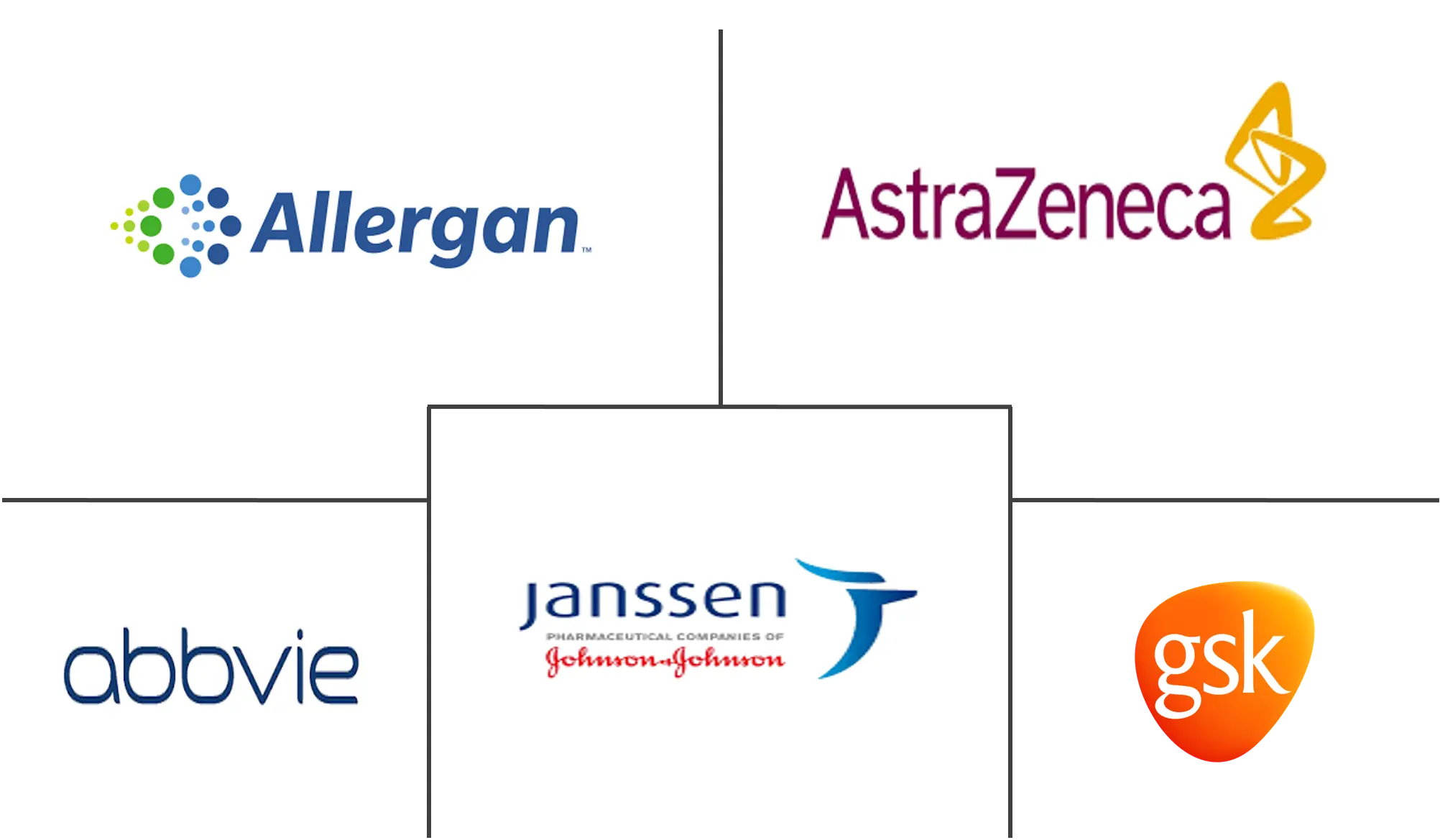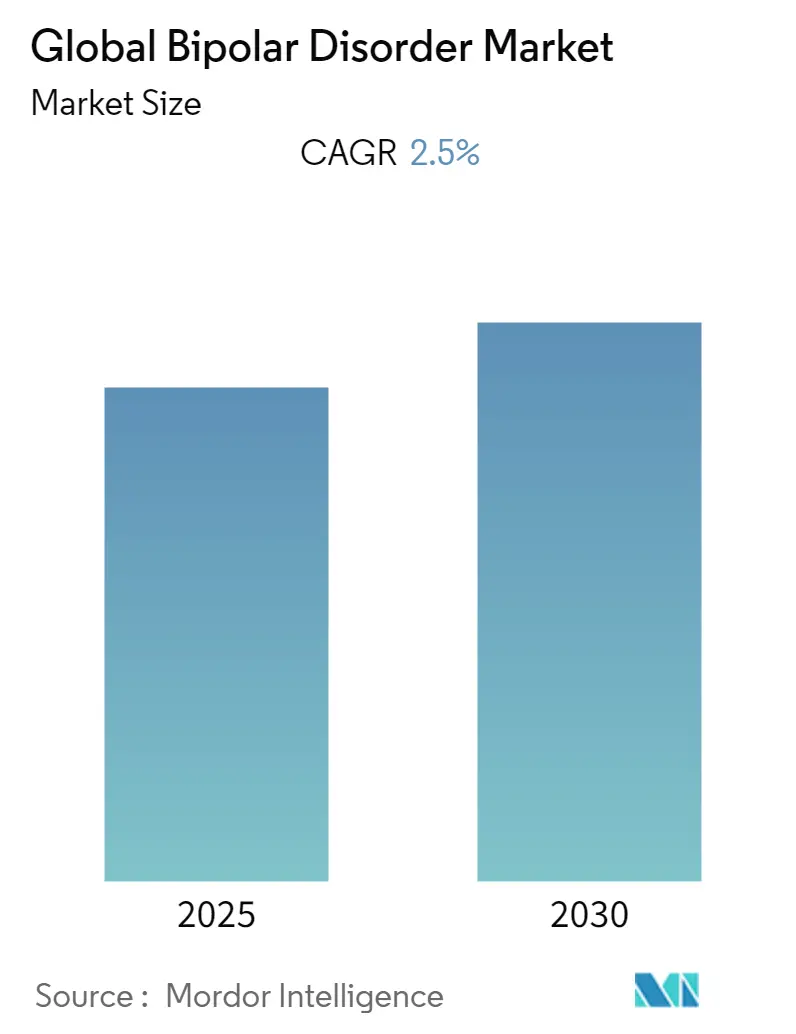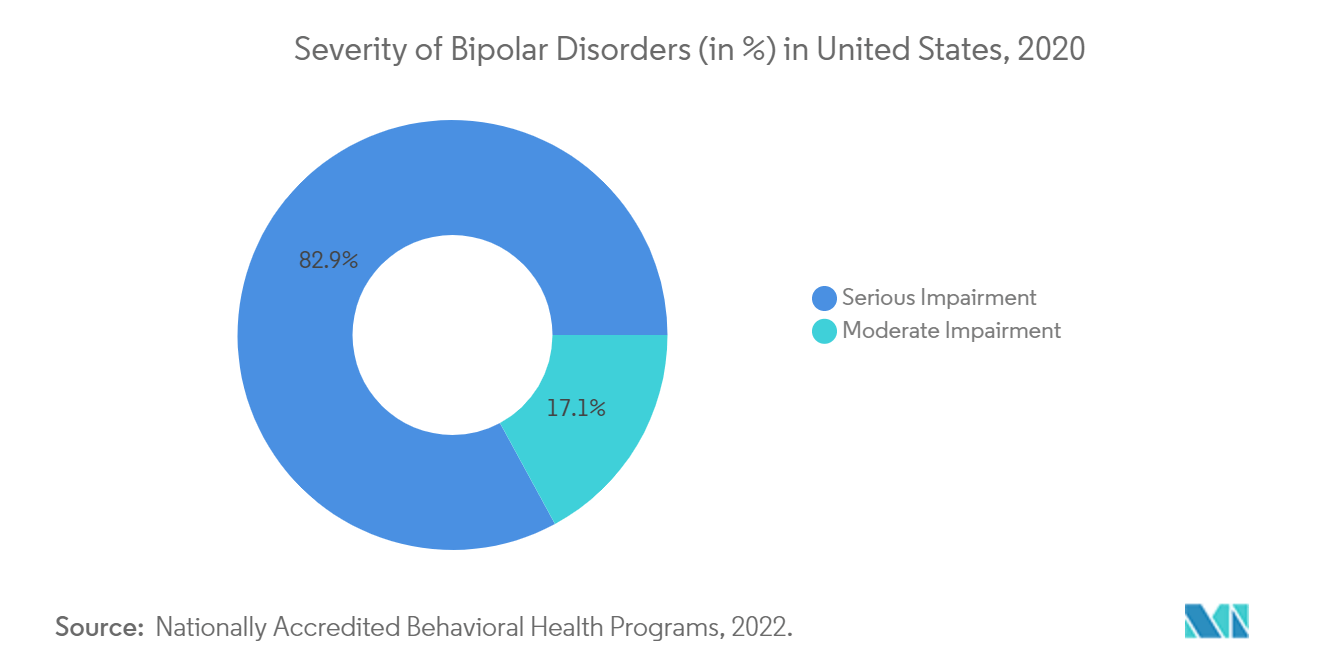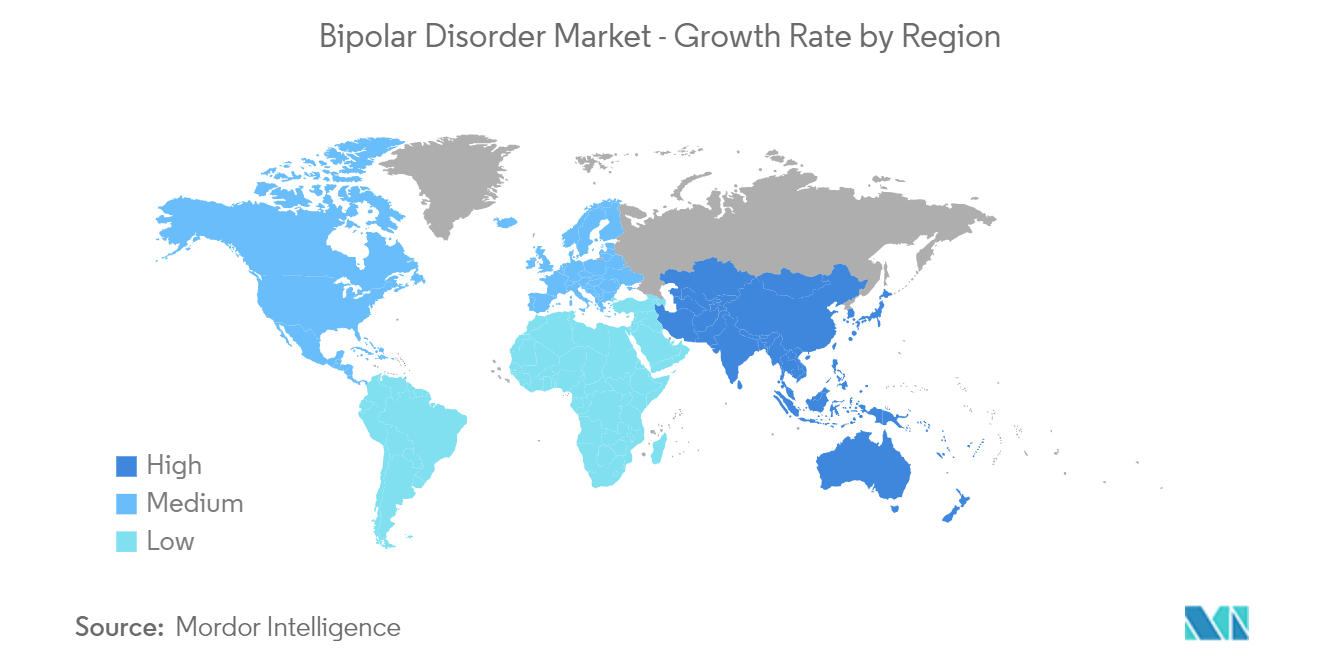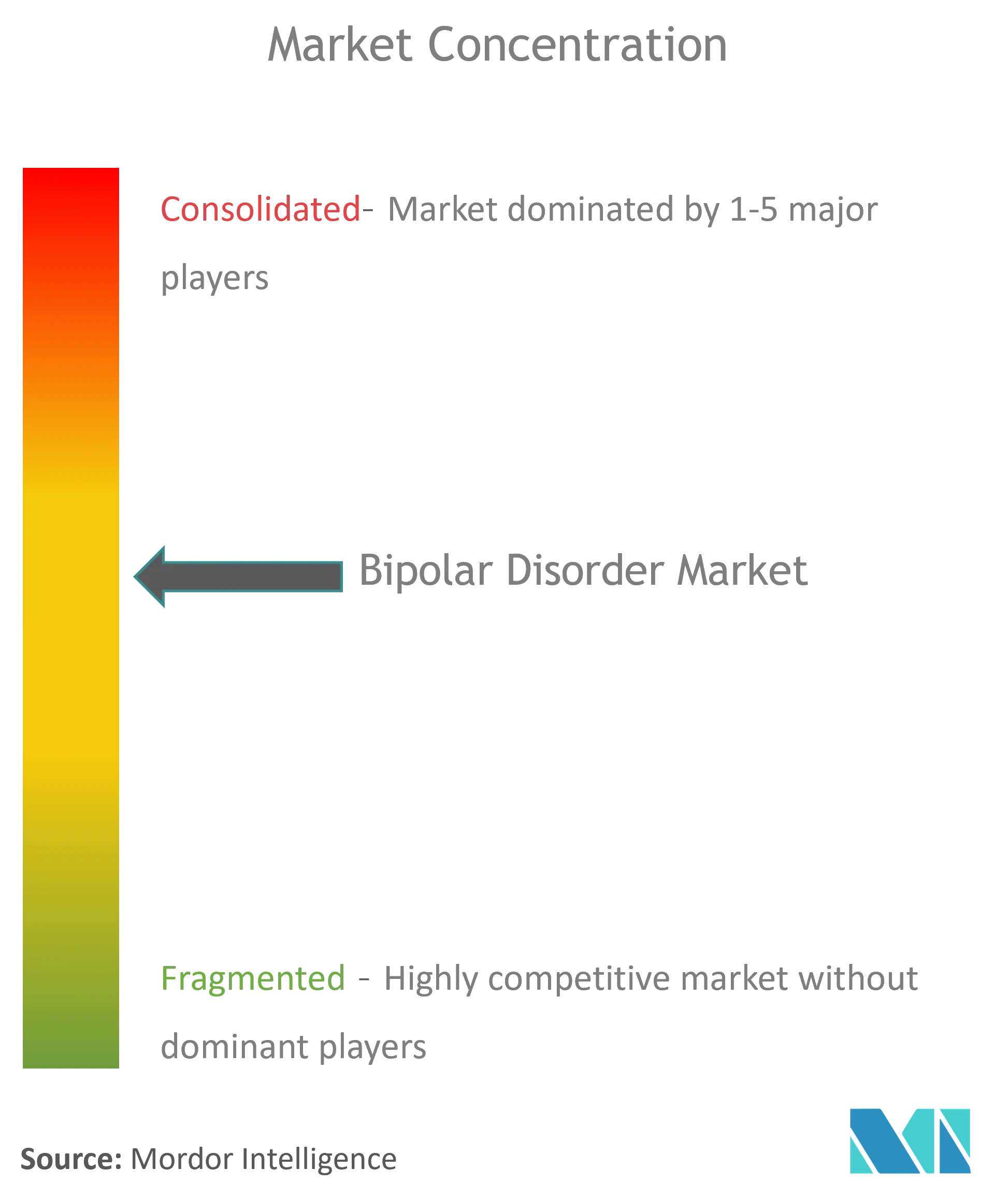Bipolar Disorder Market Analysis
The Global Bipolar Disorder Market is expected to register a CAGR of 2.5% during the forecast period.
The Covid-19 pandemic limits had a minor negative impact on the market for medications and treatments for bipolar illness. An article titled 'Implications of the COVID-19 pandemic for people with bipolar disorders: A scoping review' published in September 2021, focused on the impact of social isolation, restrictive measures, lifestyle, and biological circadian rhythms changes due to the COVID-19 pandemic, or infection-related concerns, on the clinical course of bipolar disorder (BD). Some studies found that bipolar disorder (BD) patients reported low rates of relapse or symptom worsening during the pandemic, or less severe psychiatric symptoms and higher feelings of well-being during the pandemic when compared to the pre-pandemic period. When compared to people diagnosed with major depressive disorder (MDD), bipolar disorder (BD) patients exhibited lower psychological distress.
The major factors for the growth of. the bipolar disorder market includes the increasing prevalence of the bipolar disorder, rising initiatives by government institutes to increase awareness, and technological advancements. As per an article titled 'What is the worldwide prevalence of bipolar disorder?' published in October 2021, bipolar disorder has a lifetime prevalence of about 1% and a one-year prevalence of about 0.5% worldwide. Bipolar I disorder has greater rates than bipolar II disorder.According to World Health Organization (WHO) key facts updated in June 2022, 1 in every 8 people in the world live with a mental disorder. Due to the COVID-19 pandemic, the number of people who suffer from anxiety and depressive illnesses greatly increased in 2020. Initial projections indicate a 26% and 28% increase in depressive disorders and anxiety, respectively, in just one year. As per the same source, in 2020, 40 million people experienced bipolar disorder. People with bipolar disorder experience alternating depressive episodes with periods of manic symptoms. As per an article titled 'The prevalence and clinical correlates of medical disorders comorbidities in patients with bipolar disorder' published in March 2022, Medical problems are very common in Chinese bipolar disorder (BD) sufferers. The concomitant medical diseases in BD patients relate to smoking, the frequency of depressive episodes, the onset age, and the duration of the illness. Clinicians should be aware of the co-occurring medical conditions in BD patients and take appropriate action to enhance treatment outcomes and lessen suffering.
Most of the healthcare industry's resources and professionals were directed toward the control of the Covid-19 threat because there were numerous positive cases of individuals who had been infected by the new Corona Virus. Particularly, there was a sharp decline in hospital and healthcare institution demand for bipolar medications. Surprisingly, during the global ban on the free movement of people, the number of patients with bipolar disorders surged considerably. This assumption is based on data indicating a rise in the quantity of over-the-counter bipolar medications available during pandemic periods. However, the expansion of the availability of bipolar medications on e-commerce sites maintains the market growth for prescription pharmaceuticals.
There is an increasing prevalence of bipolar disorder owing to the various risk factors, such as substance abuse, high stress, and others. The typical age of onset is the late teens or the early 20s, and depression is common in people diagnosed with bipolar. The probability of men and women being affected by bipolar disorder is similar. Therfore, the rise in the cases of the disease and the increasing need to manage them effectively has led to the growth of the bipolar disorder market. Although many of the medications used to treat bipolar disorder have linked adverse effects, these include drug addiction, diabetes and cholesterol problems, blurred vision, and liver and thyroid damage, among others. A handful of the medications have also been associated in studies with serious side effects such as kidney failure and teratogenic effects on the fetus when taken by pregnant women. Additionally, bipolar illness may frequently be misdiagnosed as depression or a personality problem, which may reduce the rates of both diagnosis and treatment for this mental disorder.
Bipolar Disorder Market Trends
Antipsychotic Drugs are Expected to be Fastest Growing Segment Over the Forecast Period
Antipsychotic medications are used as a short-term treatment for bipolar disorder to control psychotic symptoms, such as hallucinations, delusions, or mania symptoms. These symptoms may occur during severe depression or acute mania. Some also treat bipolar depression, in preventing future episodes of mania or depression. As per an article titled 'Medications for bipolar disorder: What you should know' published in May 2022, the National Institute of Mental Health estimates that 2.8%Trusted Source of adults in the United States has bipolar disorder. Acute manic psychosis is being increasingly managed with 2nd-generation antipsychotics, such as Aripiprazole, Cariprazine, Lurasidone, Olanzapine, and many more. Although any of these drugs may have extrapyramidal adverse effects and cause akathisia, the risk is lower with more sedating drugs such as quetiapine and olanzapine.
In people with antipsychotics, bipolar disorder is also used "off label" as sedatives, for insomnia, anxiety, and/or agitation takes the mood-stabilizing drug and can decrease the symptoms of mania until mood stabilizers take full effect. Some antipsychotics stabilize moods on their own and they may be used alone as a long-term treatment for people who do not tolerate or respond to lithium and anticonvulsants. A few antipsychotic drugs include asenapine (Saphris), aripiprazole (Abilify), cariprazine (Vraylar), and clozapine (Clozaril), lurasidone (Latuda), quetiapine (Seroquel), olanzapine (Zyprexa), risperidone (Risperdal), and ziprasidone (Geodon).
Many Companies contribute to the growth of the market by launching products. For instance, in December 2021, Zydus Cadila gets the United States Food and Drug Administration (USFDA) approval to market generic drug Cariprazine capsules, which are used in the treatment of schizophrenia. Additionally, in December 2021, Intra-Cellular Therapies, Inc. announced that the United States Food and Drug Administration (FDA) approved CAPLYTA for the treatment of depressive episodes associated with bipolar I or II disorder in adults, as monotherapy and as adjunctive therapy with lithium or valproate.
North America is Expected to Dominate the Market Over the Forecast Period
North America is found to hold a major share for the bipolar disorder market and is expected to show a similar trend over the forecast period, without significant fluctuations. Due to the increasing cases of bipolar disorder and the presence of better healthcare infrastructure, the market is expected to witness high growth over the forecast period. According to the data published by the National Alliance on Mental Illness, around 1 in 5 adults in the United States experiences mental illness in a given year. Hospitalization is required for severe episodes of mania and depression to protect the patients from injuring themselves or others. According to the NIMH, bipolar I disorder is characterized in part by manic symptoms that are so severe that the person needs immediate hospital care. There is a huge need to tackle bipolar disorder, as it is an increasing problem, and hence, the market for bipolar disorder is expected to grow during the forecast period.
Approvals of products by United States Food and Drug Administration (USFDA) in the region is expected to promote market growth. For instance, April 2022, the United States Food and Drug Administration has approved a new drug from BioXcel used to treat patients with schizophrenia or bipolar I or II disorder. Similarly, In May 2021, Alembic Pharmaceuticals gets United States Food and Drug Administration (USFDA) approval for bipolar depression drug - Lurasidone Hydrochloride tablets, used to treat bipolar depression.
Bipolar Disorder Industry Overview
The market studied is a moderately consolidated market owing to the presence of small and large market players. Some of the market players are AbbVie Inc., Allergan PLC, AstraZeneca Plc, Eli Lilly and Company, GlaxoSmithKline Plc, Janssen Pharmaceuticals Inc., Novartis AG, Otsuka Holdings Co. Ltd, and Pfizer Inc.
Bipolar Disorder Market Leaders
-
AbbVie Inc.
-
Allergan PLC
-
AstraZeneca Plc
-
GlaxoSmithKline Plc
-
Janssen Pharmaceuticals Inc.
- *Disclaimer: Major Players sorted in no particular order
Bipolar Disorder Market News
- In April 2022, The United States Food and Drug Administration approved Intra-Cellular Therapies Inc. for 10.5 mg and 21 mg dosages of lumateperone to treat schizophrenia and bipolar depression.
- In April 2022, BioXcel Therapeutics, Inc. announced that the United States Food and Drug Administration (FDA) has approved IGALMI (dexmedetomidine) sublingual film for the acute treatment of agitation associated with schizophrenia or bipolar I or II disorder in adults.
- In June 2021, Alkermes plc announced that the United States Food and Drug Administration has approved LYBALVI (olanzapine and samidorphan) for the treatment of adults with schizophrenia and the treatment of adults with bipolar I disorder.
Bipolar Disorder Industry Segmentation
As per the scope of this report, bipolar disorder is a mental illness marked by extreme shifts in mood. Symptoms may include an extremely elevated mood called mania, and also episodes of depression. Bipolar disorder is also known as bipolar disease or manic depression. People with bipolar disorder may have trouble managing everyday life tasks at school or work, or maintaining relationships. There's no cure, but there are many treatment options available that can help with managing the symptoms. The Bipolar Disorder Market is segmented by Drug Class (Mood stabilizer, Anticonvulsant, Antipsychotic Drug, Antidepressant Drug, and Other Classes of Drug), by Mechanism of Action (Selective Serotonin Reuptake Inhibitor, Serotonin Norepinephrine Reuptake Inhibitor, Tricyclic Antidepressant Drug, Beta Blockers, Others), and Geography (North America, Europe, Asia-Pacific, Middle East & Africa, and South America). The market report also covers the estimated market sizes and trends for 17 different countries across major regions, globally. The report offers the value (in USD million) for the above segments.
| By Drug Class | Mood stabilizer | ||
| Anticonvulsant | |||
| Antipsychotic Drug | |||
| Antidepressant Drug | |||
| Other Classes of Drug | |||
| By Mechanism of Action | Selective Serotonin Reuptake Inhibitor | ||
| Serotonin Norepinephrine Reuptake Inhibitor | |||
| Tricyclic Antidepressant Drug | |||
| Beta Blockers | |||
| Others | |||
| Geography | North America | United States | |
| Canada | |||
| Mexico | |||
| Europe | Germany | ||
| United Kingdom | |||
| France | |||
| Italy | |||
| Spain | |||
| Rest of Europe | |||
| Asia - Pacific | China | ||
| Japan | |||
| India | |||
| Australia | |||
| South Korea | |||
| Rest of Asia-Pacific | |||
| Middle-East and Africa | GCC | ||
| South Africa | |||
| Rest of Middle-East and Africa | |||
| South America | Brazil | ||
| Argentina | |||
| Rest of South America | |||
Bipolar Disorder Market Research FAQs
What is the current Global Bipolar Disorder Market size?
The Global Bipolar Disorder Market is projected to register a CAGR of 2.5% during the forecast period (2025-2030)
Who are the key players in Global Bipolar Disorder Market?
AbbVie Inc., Allergan PLC, AstraZeneca Plc, GlaxoSmithKline Plc and Janssen Pharmaceuticals Inc. are the major companies operating in the Global Bipolar Disorder Market.
Which is the fastest growing region in Global Bipolar Disorder Market?
Asia-Pacific is estimated to grow at the highest CAGR over the forecast period (2025-2030).
Which region has the biggest share in Global Bipolar Disorder Market?
In 2025, the North America accounts for the largest market share in Global Bipolar Disorder Market.
What years does this Global Bipolar Disorder Market cover?
The report covers the Global Bipolar Disorder Market historical market size for years: 2019, 2020, 2021, 2022, 2023 and 2024. The report also forecasts the Global Bipolar Disorder Market size for years: 2025, 2026, 2027, 2028, 2029 and 2030.
Our Best Selling Reports
Bipolar Disorders Treatment Industry Report
Statistics for the 2025 Global Bipolar Disorder market share, size and revenue growth rate, created by Mordor Intelligence™ Industry Reports. Global Bipolar Disorder analysis includes a market forecast outlook for 2025 to 2030 and historical overview. Get a sample of this industry analysis as a free report PDF download.

